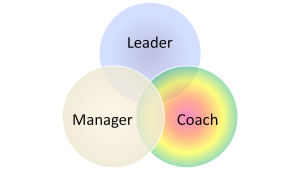A Guide to Coaching Your Employees

Benefits of the coaching style of leadership were discussed in a previous post. While very effective, coaching was reported to be the least utilized of all six styles. For those who would like to give it a try, or already use a coaching style, this post identifies various approaches that help you, as a manager, match your approach to your employee’s stage of development.
Coaching approaches cover the range of:
- Show, Tell, Practice, Observe, Feedback
- Suggest
- Guide
- Insight
- Principles
The list is ordered from most to least instruction by the coach and from the least experienced to the most advanced employees. Step 1 typically applies to employees who are new to their role, with little or no prior experience. At step 4, Insight, you’re helping employees uncover their own insights to solving problems and improving performance. Each phase will be discussed in more detail in this and subsequent posts.
When Should You Coach Employees?
Unlike formal coaching with an external coach, the manager can and should coach employees as needed and as opportunities arise. The best time is when he/she asks for help. In addition, regularly scheduled coaching sessions ensure your availability and set the expectation that coaching is part of the manager employee relationship.
When to Show, Tell, Practice, Observe and Provide Feedback
Perhaps you’ve coached a child who’s never held a baseball bat, gone ice skating, or taken a swim. In these situations it’s best to show and tell. Picture coach Martha standing behind Evie, a new player, as the young girl grabs the bat. Evie places one hand above the other, but holds the bat too low. Coach Martha demonstrates by placing Evie’s hands lower on the bat. As she does so, she instructs Evie to hold the bat lower and explains why this works best. Evie then practices the hold until she gets the feel of it. The coach offers feedback and encouragement. “That’s much better” “Still a little too low.” “Oops, looks like you’ve gone too high this time.”
Coaching a New Employee
Now imagine coaching Dan, a new sales employee who’s never made a customer call. The first show and tell demo may go something like this. Joe, Dan’s manager brings Dan along to observe a sales call. First, however, Joe tells Dan who will be there, how Joe will begin the meeting, what he wants to achieve, and what he expects of Dan. Dan and Joe review the call when it’s over. It’s best to ask Dan what he noticed. By doing so, you begin to hand over responsibility for learning to the student. Coaching is, in fact, a process of handing off more and more to the student, while the coach offers less and less showing, telling, guiding, questioning, etc.
Practice, observation and feedback comes next. This may be a multi-step process beginning with Dan crafting the meeting agenda, then having an assigned role in a customer call, such as opening the meeting. Following the call, Dan and Joe debrief. Again, it’s best to ask Dan what he thinks went well, what he might do differently next time, and what questions he’d like to discuss. This allows the coach to gauge Dan’s readiness for feedback and next steps in the learning process.
Extra Tip – Recent Learners Make Good Coaches
After several failed attempts to teach my son how to blow bubbles with chewing gum, I learned that a newbie to the skill was a much more adept coach. I, on the other hand, had blown so many bubbles that I could no longer reduce the art to individual steps. It helps to enlist recent learners as adjunct coaches.
You can read about Suggesting and Guiding in the next post.


